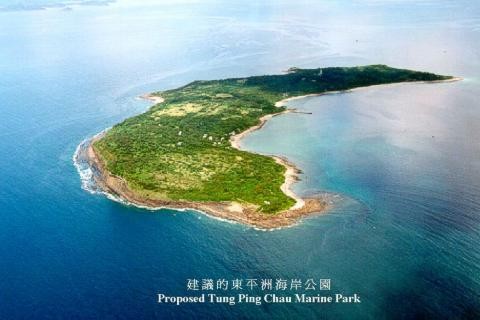On 7 January 2001, we went to Tung Ping Chau having our second bird-watching cum hiking activity. Tough we did not see many birds this time, we both enjoyed the trip very much. Tung Ping Chau is really a nice place. Remote from the busy urban area, everything is so peaceful there. So, this trip was definitely good for us, the city dwellers, to take a real spiritual rest.
At the Ma Liu Shiu pier, where we took boat to Tung Ping Chau, we already spotted few shore birds, namely Little Ringed Plover, Little Egret, Great Egret, and Common Sandpiper. On the way towards Tung Ping Chau, we also saw a number of Great Egrets flying over us. It was so close and near, fantastic!!!!!!
Arriving in Tung Ping Chau, before we could start our bird-watching walk, the first gate we needed to get through was the policemen checking our HKID card to make sure of no I.I. OK, everything done. We could start our tracking. We walked to the fung shui woodland around the police post and the disused Ping Chau Camp. Walking along the footpath, we kept hearing numerous birds' callings. But we always failed to find where they were. Indeed, this is a challenge of watching woodland birds, especially for us as the bird-watching beginners. As the woodland vegetations are so dense and bushy, birds can easily hide up and use the color of nature to protect themselves. Consequently, we only successfully saw the Chinese Bulbuls, Crested Bulbuls, Spotted Dove, Magpie Robin, and Japanese White Eyes. Over the high sky, we saw Kits and Eagles. But the number of species was surely more than the above, as we did hear many many birds calling.
|
|
||
|
Crested Bulbul (Acknowledgment: photo provided by Michelle) |
||
|
Another reason why we hardly saw the birds is wrong timing. Normally, between 11:00 to 17:00 is not the best time for the search of migrants. But we were on the island exactly during that times. So, bird-watchers are suggested to take the Saturday ferry and stay on the island overnight, then you can enjoy bird-watching during early morning. Though we did not see many birds, we were not disappointed at all. We do understand the rule that birds are in wild. They are not obliged to show up for us. After lunch, we headed the abandoned reservoir, hoping that we could see more birds. Surprisingly, we saw some interesting and new species, such as Plain Prinia, Great Tit, and Arctic Warbler, which is a passage migrant and is found of great number on Tung Ping Chau.
|
Off the pier at Ma Liu Shiu, sailing via Tolo Harbour and Mirs Bay, we saw a number of spots with red tide. We even saw its outbreak on Tung Ping Chau.

|
red
tide
Algal
blooms are natural phenomena in which microscopic, single-celled
algae multiply very fast or "bloom". Some algal blooms
discolour the seawater turning it to pink, red, brown, reddish-brown
or deep green and are called Red
Tides.
|
|

Acknowledgement: Thanks Mr. Bob THOMPSON for providing the photos |
Though Red tide is a natural phenomenon, man-made pollutions can be a factor intensifying its occurrence. The domestic and industrial sewage discharges, containing nitrogen and phosphorus, provide organic nutrients for the blooming of algae. Receiving the sewage discharge from the big new towns of Shatin, Taipo, and Ma On Shan everyday, Tolo Harbour has been suffering from organic pollutions over the two decades, revealed by the increasing outbreak of red tide from less than 5 times a year in early 80's to more than 25 in 90's. |
One of the indicator on the outbreak of red tide is dead fish. On Tung Ping Chau, we also found a number of dead fishes on land.
 |
To be an
environmental citizen, it is our responsibility to report any
occurrence of red tide if you see it. The AFCD's red tide
reporting hotline is:
Telephone
No.: 2150 7081 (office hours)
|



